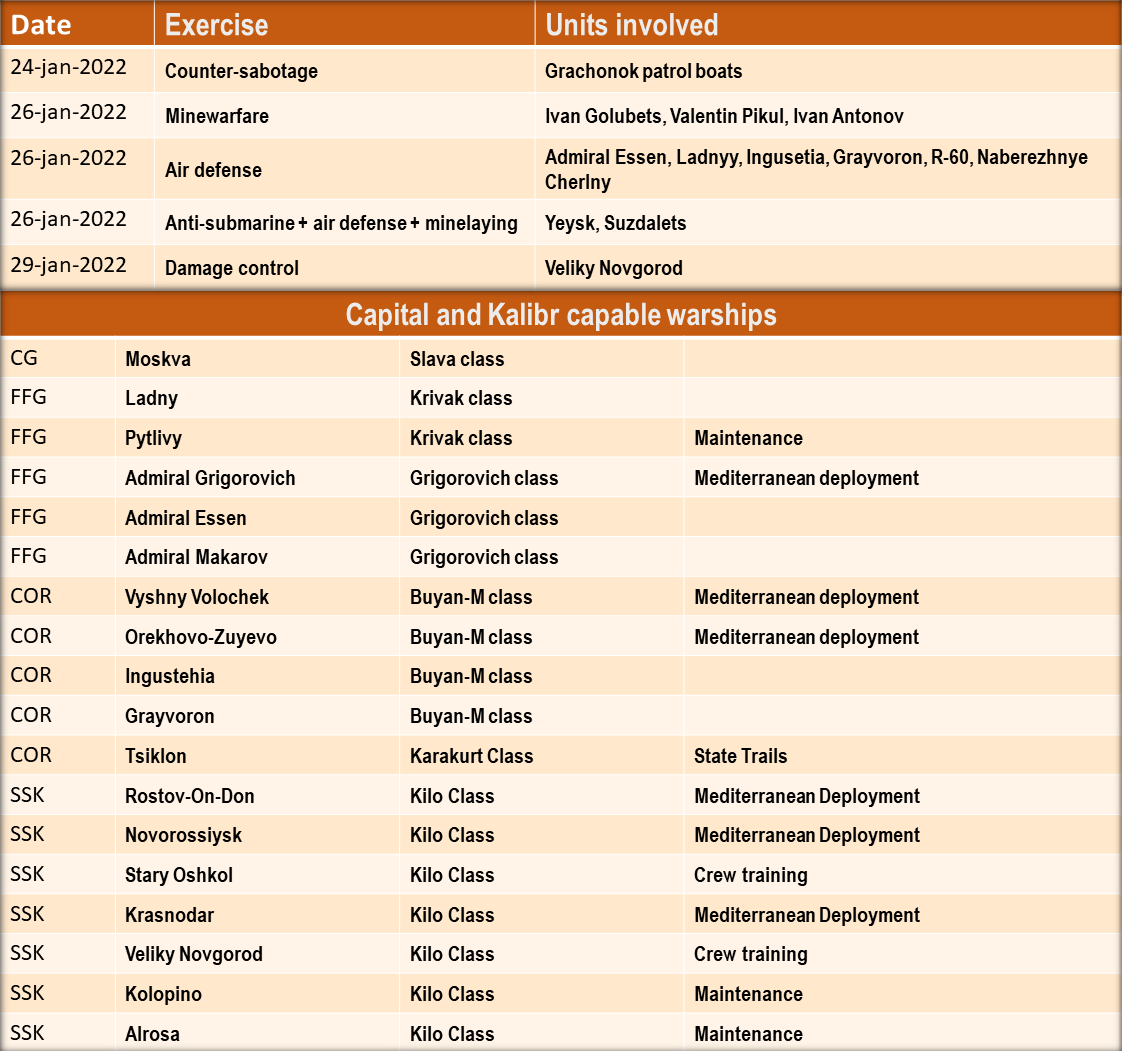Black Sea Fleet deployments-Wk04/2022
Fleet overview
Weekly Brief
Significant naval activity was observed when the Black Sea Fleet held a large scale naval exercise in the vicinity of Sevastopol halfway the week. Three different task groups were observed exercising in a wide variety of naval combat tasks. The exercise were part of a larger series of exercises across the entire Russian Navy.
Karakurt class vessel Tsirkon and Improved Kilo class submarine Veliky Novgorod continue their qualification tracks with state trails and crew training being held respectivly.
Daily Events
January 24
PDSS troops were involved in an anti-sabotage exercise at an undisclosed location at the Black Sea. The PDSS detachment used the Kalmar complex to search and locate a group of underwater saboteurs. The detachment was then deployed from a Grachonok class patrol boat and engaged the saboteurs underwater with special small arms. The detachment also inspected the area for the presence of mine-explosive devices [1].
January 25
Rescue tug Prof Nikolay Maru (SB-565) entered the naval base of Sevastopol. The vessel previously departed Novorossiysk [2].
January 26
Around 20 vessels departed the naval bases of Sevastopol and Novorossiysk for a large scale naval exercise in the Black Sea. The exercise is part of a larger fleet-wide deployment that will involve over 140 warships and supply vessels conducting exercises around Russia. The Black Sea Fleet deployed frigates, corvettes, missile boats and minehunters for this exercise [3]. Grigorovich class frigate RFS Admiral Essen, Krivak class frigate RFS Ladnyy and Buyan-M class corvette RFS Ingusetia were seen leaving the Sevastopol naval base [4].
A minewarfare group was made composed of the Natya class minehunters RFS Ivan Golubets and RFS Valentin Pikul and Aleksandrit class minehunter RFS Ivan Antonov. This group focusses on anti-minewarfare in support of the other groups. Grisha class corvettes RFS Yeysk and RFS Suzdalets were deployed as well. These were escorted by the minewarfare group and aided in firing against simulated floated mines.
The air defense group is composed of Grigorovich class frigate RFS Admiral Essen, Krivak class frigate RFS Ladnyy, Buyan-M class corvettes RFS Ingusetia and RFS Grayvoron and Tarantul class missile boats RFS Naberezhnye Chelny and RFS R-60. These vessels conducted air defense exercises in coordination with the fighter aircraft of the Southern Military District [5] [6].
The exercises of Grisha class corvettes RFS Yeysk and RFS Suzdalets were later described in detail. The vessels first conducted a search for enemy submarines before placing training minefields along the possible transit routes taken by simulated enemy naval forces. A later exercise involved both corvettes providing air defense with their close-in weapon systems and anti-air missiles [7] [8].
January 27
Karakurt class missile ship RFS Tsiklon has commenced her state trails. These trails are expected to be carried out within one month. Upon successful completion of the trails, the vessel can enter service in the Russian Navy [9].
January 29
The crew of Improved Kilo class submarine RFS Veliky Novgorod were involved in a damage control exercise. The exercise involved putting out a fire while the submarine was moored at a quay [10].
January 30
A counter sabotage exercise took place in the naval base of Novorossiysk. Several groups of simulated insurgent forces attempted to penetrate the naval base and seize weapons. Upon receiving the alert signal, personnel on duty worked out the necessary actions to block and destroy the groups of insurgent forces [11].


